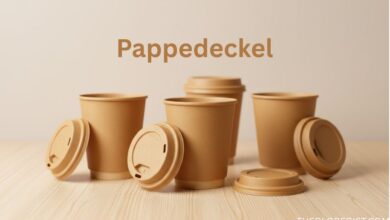Blazertje: The Versatile Little Blazer in Modern Fashion

Blazertje is a word that might sound playful, but in the world of fashion, it carries a sophisticated edge. Originating from Dutch, where the diminutive suffix -tje transforms blazer into blazertje, the term literally means “little blazer.” This lightweight, often softer-tailored garment has become one of the most versatile items in modern wardrobes. Unlike a traditional blazer that leans heavily on formality, the blazertje balances elegance with comfort, making it suitable for casual outings, work environments, and even semi-formal events.
As fashion in 2025 shifts toward adaptable pieces that bridge comfort and chic, the blazertje has carved out a unique position. From lightweight fabrics like linen for summer to structured wool blends for fall, it has evolved into a staple for individuals who want effortless style with minimal effort.
What Is a Blazertje? — Origin & Definition
The blazertje is best described as a lighter, smaller, and often more casual version of the blazer. It retains the polished silhouette of traditional tailoring but reduces the weight, lining, and sometimes even structure. The name itself comes from Dutch, where “blazer” becomes “blazertje,” indicating a subtler, more approachable garment.
While blazers have long been associated with uniforms, formal wear, and office attire, the blazertje represents a modern twist. It is designed for mobility, breathability, and versatility. Instead of the stiff formality of a suit jacket, the blazertje feels approachable — something that can be worn with jeans, skirts, or dresses.
Blazertje vs Blazer — Key Differences
Though the terms are related, there are important differences between a blazer and a blazertje:
-
Structure: A traditional blazer is structured, often with shoulder pads and full lining. A blazertje tends to be softer and less rigid.
-
Weight: Blazers are usually heavier, made with wool or wool blends. Blazertjes often come in cotton, linen, or lightweight blends.
-
Occasion: Blazers are more formal, while blazertjes thrive in smart-casual or semi-formal settings.
-
Fit: The blazertje usually has a more relaxed or slim fit, making it suitable for layering.
These distinctions allow the blazertje to stand out as a wardrobe essential for those who want style without stiffness.
Types of Blazertjes
Fashion designers have experimented with many variations of the blazertje to suit different body types, seasons, and style preferences. Some of the most popular include:
-
Cropped Blazertje: Ends above the hip, great for pairing with high-waisted pants or skirts.
-
Longline Blazertje: A modern version that extends past the hip, offering extra coverage and sophistication.
-
Collarless Blazertje: Minimalist and chic, perfect for contemporary looks.
-
Single-Breasted Blazertje: Classic, versatile, and easy to style.
-
Double-Breasted Blazertje: Adds a touch of power dressing while maintaining a lightweight feel.
Each type allows wearers to experiment with proportions, silhouettes, and layering.
Fabrics & Seasonal Choices
One of the reasons the blazertje has grown in popularity is its adaptability to seasons. The fabric choice determines how and when it can be worn:
-
Linen Blazertjes: Perfect for summer due to their breathability. They often come unlined, making them airy and comfortable.
-
Cotton Blazertjes: Great for spring and early fall, balancing structure with softness.
-
Wool Blend Blazertjes: Ideal for colder months, offering warmth without the bulk of a heavy blazer.
-
Synthetic Blends: Popular in high-street fashion, often wrinkle-resistant and affordable.
Understanding the fabric is essential when choosing a blazertje, as it impacts comfort, drape, and durability.
How to Style a Blazertje — 8 Outfit Ideas
One of the main appeals of the blazertje is its styling versatility. Here are some outfit inspirations:
-
With Jeans and a T-shirt: A casual yet sharp look for weekend outings.
-
Over a Dress: Adds sophistication to a casual dress, ideal for brunch or dinner dates.
-
Office Ready: Pair with tailored trousers and loafers for a relaxed office vibe.
-
Layered with Knitwear: A lightweight blazertje over a thin sweater for fall chic.
-
With Shorts: Perfect for summer — balance structure with casual bottoms.
-
Evening Look: Style with silk camisole and heels for a semi-formal evening.
-
Streetwear Mix: Oversized blazertje with sneakers for a trendy, urban feel.
-
Monochrome Outfit: Match with trousers of the same shade for a minimalist statement.
Fit & Tailoring Advice
When buying a blazertje, fit is everything. Consider these points:
-
Shoulders: The seam should sit naturally at the shoulder bone.
-
Sleeves: Ideally, the sleeve ends at the wrist bone, showing a hint of shirt cuff if worn formally.
-
Length: Cropped versions should skim the waistline; longline versions should not overwhelm the frame.
-
Mobility: A good blazertje allows ease of movement, unlike stiffer blazers.
Tailoring is also a great option if you want a perfect fit, especially for professional or semi-formal wear.
Care & Maintenance — Keeping It Sharp
A blazertje, due to its lightweight materials, requires proper care:
-
Linen/Cotton: Steam instead of iron to avoid shine marks.
-
Wool Blends: Dry-clean occasionally, but air them out between wears.
-
Storage: Hang on padded hangers to maintain shape.
-
Travel Tip: Roll gently instead of folding to minimize wrinkles.
These small practices keep the blazertje crisp and long-lasting.
Why the Blazertje Is Trending in 2025
The rise of the blazertje is linked to several broader fashion trends:
-
Smart-Casual Dressing: Work-from-home culture and flexible offices demand clothes that balance comfort and polish.
-
Gender-Neutral Fashion: Blazertjes are styled across genders, breaking traditional norms.
-
Celebrity Endorsement: Many celebrities and influencers showcase blazertjes in streetwear and red-carpet outfits.
-
Sustainability Movement: Lightweight designs use less material and adapt across multiple occasions, aligning with sustainable wardrobes.
The blazertje is not just clothing; it reflects how modern society values adaptability, minimalism, and effortless style.
Where to Buy & What to Look For
When shopping for a blazertje, here are some tips:
-
Quality Fabric: Opt for natural fibers if possible.
-
Versatility: Choose neutral colors like black, navy, beige, or gray for maximum styling potential.
-
Detailing: Pay attention to lapel shapes, buttons, and lining.
-
Brands & Retailers: Both high-end designers and fast-fashion outlets offer variations, so find one that balances quality and budget.
Conclusion
The blazertje is more than just a diminutive blazer; it represents a modern approach to fashion where comfort meets elegance. From casual weekends to professional settings, it serves as a go-to piece that adapts to every style need. In 2025, as fashion continues to move toward versatility and sustainability, the blazertje stands out as a timeless yet modern wardrobe essential.
For more in-depth style insights and fashion analysis, check out The Globe Gist, where we dive deeper into evolving fashion trends and timeless wardrobe pieces like the blazertje.
Q1: What is a blazertje?
A blazertje is a lightweight, slightly more casual version of a blazer. The term comes from Dutch, meaning “little blazer,” and it is designed for versatility and comfort.
Q2: How is a blazertje different from a regular blazer?
Unlike a traditional blazer, a blazertje is softer, less structured, often lighter in fabric, and ideal for smart-casual or semi-formal occasions.
Q3: What fabrics are commonly used for blazertjes?
Blazertjes are typically made from cotton, linen, wool blends, or lightweight synthetic fabrics. Linen is great for summer, wool blends for colder months, and cotton for spring and fall.
Q4: How should I style a blazertje?
Blazertjes can be styled with jeans, trousers, skirts, dresses, or even shorts. They work for casual outings, office wear, and semi-formal events, offering a versatile fashion option.
Q5: How do I choose the right fit for a blazertje?
Ensure the shoulder seam aligns with your shoulder, sleeves end at the wrist bone, and the length complements your torso. Tailoring can improve fit for a polished look.
Q6: How do I care for a blazertje?
Care depends on the fabric: steam linen or cotton to avoid wrinkles, dry-clean wool blends occasionally, and always hang on padded hangers to maintain shape.
Q7: Are blazertjes suitable for men and women?
Yes, blazertjes are unisex and can be styled in gender-neutral ways, making them a flexible wardrobe staple for everyone.
Thanks for read our article if you want more like this kind of article visit our site The Globe Gist, and comment us. We provide authentic & comprehensivf information to our readers.



